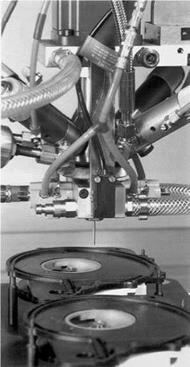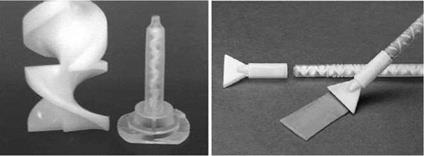The curing reaction of two-part adhesives takes place after mixing at room temperature, without any need to apply pressure. The adherents must be fixed to avoid movement of the adhesive joint before the cure is complete; this can be accomplished
|
Table 6.1 Processing of physically setting adhesive systems according to their application forms and setting mechanisms.
EVA = ethylene vinyl acetate; PSA = pressure-sensitive adhesive. |
by mechanical fixtures and fasteners, or by supporting pressure-sensitive adhesive strips.
Depending on the chemical setting mechanisms of the adhesives, specific mixing qualities are required for proper processing and curing. A wide range of mixing ratios may be used for radical curing systems without any serious loss in strength, while polyaddition adhesives (e. g. epoxy resins) and polyaddition curing polyurethane adhesives require a precise mixing ratio to be met with a maximum allowance of a few percent. Otherwise, nonreacted monomers carry the risk of softening the polymeric network, leading to a poor mechanical performance of the bonded joint.
The quality of the adhesive mixture depends on the metering ratio and the homogeneity of mixing. The following methods are available for metering and mixing two-component adhesives:
• batch processing; metering by weighing and mixing with manual or power stirrers
• static mixers
• dynamic mixing heads
For batch processing, the components are dosed and mixed batchwise. During and after mixing, the pot life — that is, the period of time in which a multipart adhesive can be used after mixing the components — has already started to expire. If the whole mixture is not scheduled for immediate processing, freezing may quench the reaction almost completely. In the optical industry, this method is used in order to carry out extensive quality assurance measures on the adhesive mixture before releasing it for further manufacture.
A continuous processing of two-part adhesives is made possible by means of static mixers consisting of a cylindrical tube with mixing elements, applying the principles of fluid mechanics. The Kenics helix is the most popular device, and comprises a series of mixing elements with right-hand and left-hand twisted elements being arranged alternatively. This principle is applied both in micromixers and in the mixing heads of machine processing units (Figures 6.19 and 6.20, right-hand image).
|
|||||||||||||||||||||||||
|
Figure 6.19 Different types of static mixer which use Kenics helices. |
|
Figure 6.20 Left: The adhesive components mixing as they pass along the mixing elements. Right: Different mixing helices; upper: a Sulzer static mixer; lower: the Kenics helix. |
Alternatively, static mixers with rectangular cross-section profiles according to Sulzer may be used (Figure 6.20, right-hand image). These provide for a compact length of the mixer.
The mixing quality obtained with this type of system depends on the number of mixing elements arranged in series, and on the viscosity properties of the adhesive. The driving energy force for the mixing process is the initial pressure of the adhesive components. Unless the manufacturer has already released the static mixers, it is of utmost importance to test the equipment settings by taking samples for controlling the metering and mixing quality. Note: A visual check of whether the material has been mixed homogeneously is usually not sufficient for the purpose of quality assurance.
Due to their simple layout and low unit costs, disposable static mixers are widely used. In any case, static mixers must be replaced whenever the pot life at the opening of the nozzle has been exceeded due to interruptions and delays in the processing chain, or whenever the viscosity of the adhesive material in the mixing tube has increased to such an extent that the dispensing pressure has exceeded limiting values.
More complex dynamic mixing heads (Figure 6.21) use a rotor in the mixing chamber of the application head to mix the adhesive components.
Figure 6.21 Metering and dynamic mixing of two-component adhesives. (Photo courtesy ofRampf, Dosiertechnik).
 Whenever production comes to a standstill for a long period, the mixing chamber must be purged with an inert liquid to prevent the adhesive from curing and the rotor from blocking. The purging liquid is then removed using compressed air, and may be recycled after having removed the adhesive components in a closed circuit. Whenever there is a need to span short pauses, in order to save costs, the mixing chamber can also be purged by dispensing a small quantity of adhesive (‘blind shots’) or purging with just a single component of the adhesive system; this allows the mixing chamber to be refilled upon reuse, without the need to use a special purging agent. Importantly, any incorrectly mixed adhesive material must be disposed of according to the manufacturer’s health and environmental safety recommendations [11].
Whenever production comes to a standstill for a long period, the mixing chamber must be purged with an inert liquid to prevent the adhesive from curing and the rotor from blocking. The purging liquid is then removed using compressed air, and may be recycled after having removed the adhesive components in a closed circuit. Whenever there is a need to span short pauses, in order to save costs, the mixing chamber can also be purged by dispensing a small quantity of adhesive (‘blind shots’) or purging with just a single component of the adhesive system; this allows the mixing chamber to be refilled upon reuse, without the need to use a special purging agent. Importantly, any incorrectly mixed adhesive material must be disposed of according to the manufacturer’s health and environmental safety recommendations [11].
 9 октября, 2015
9 октября, 2015  Pokraskin
Pokraskin 

 Опубликовано в рубрике
Опубликовано в рубрике 